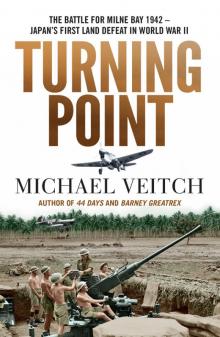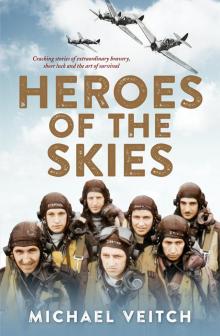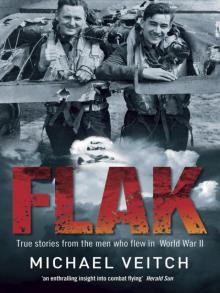- Home
- Michael Veitch
Turning Point Page 7
Turning Point Read online
Page 7
One witness to the arrival of the Kittyhawks was Warrant Officer Geoff Baskett. ‘There was a terrific crash as each of the planes landed on the steel matting,’ he recalled. ‘None of the pilots had landed on this type of surface before, and one of the pilots told me later that he thought his propeller had fallen off, judging by the noise of the landing.’
With both squadrons now on the deck, No. 1 Strip suddenly looked dangerously crammed. ‘If the Japs drop by in the next few hours,’ remarked Truscott as the last of 75 Squadron’s aircraft touched down, ‘these squadrons will be murdered in the mud.’ Over the next few days, the issue would be compounded by the arrival of four Lockheed Hudsons from 6 Squadron, which were to perform vital reconnaissance missions.
It was a situation, however, that had been well anticipated. Hence, a few miles to the east, the construction of Milne Bay’s second airstrip, designated No. 3, was well underway. Along with consideration of the sheer numbers of aircraft the Milne Bay base needed to accommodate, it was deemed essential to give the pilots alternative landing and taking-off arrangements, so they could cope with various flying conditions. No. 2 Strip, originally pegged out in the swampy area behind Gili Gili, had recently been abandoned due to the difficulty of its terrain and access, but the new No. 3 Strip, running north–south and almost directly down to the water for ease of approach, would form the garrison’s most easterly defence. In just a few weeks’ time, though still unfinished, it would provide the stage for the terrible climax of the battle for Milne Bay.
Until No. 3 Strip was operational, No. 1 would serve as the mainstay of Milne Bay’s aerial arsenal. Working around the clock, engineers and ground staff constructed dispersal areas from the abundance of coconut logs, to provide some protection from shrapnel blasts and bullets, and to prevent a chain reaction if one aircraft blew up.
The newly arrived pilots of the two squadrons had little time to reflect on the strip’s shortcomings. Hardly had their propellers stopped turning than they were refuelled and ordered to start flying standing patrols. The garrison’s inexplicable invisibility to the Japanese, it was assumed, would not last.
Later that afternoon, four of 75 Squadron’s pilots, already in the air providing top cover at 30,000 feet, reflected on how much the conditions had changed since their first stint at Moresby. Back then, the April sky had been relatively clear; now it was a soup of mists, rain and cumulus clouds. Suddenly they heard a crackle over their unreliable radio sets – that much at least had not changed since Moresby – directing them to intercept an approaching enemy aircraft.
Racing through the mist behind their CO, Les Jackson, the pilots swallowed hard as they broke into a patch of clear sky, then sighed as they saw that the ‘enemy’ was in fact an RAAF Catalina flying boat. Flicking their aircraft around, they headed back to make their second landing at No. 1 Strip that day.
Ten days later, on 4 August, with the Japanese still having apparently failed to notice the existence of the Milne Bay garrison, something approaching a sense of complacency began to settle on the men. Then, just after midday, as some members of 76 Squadron who had worked to put the morning’s standing patrol of eight Kittyhawks into the air were resting inside their tent, an unfamiliar engine note was detected, quite different from the familiar throb of a Kittyhawk’s liquid-cooled motor. It was the unmistakable ‘chop’ of a radial engine approaching from the north.
Leading Aircraftsman John Short initially thought little of it. ‘Some silly bugger is playing around,’ he remarked to one of his mates. Above the tree canopy, a pale low-wing monoplane appeared. ‘What are Wirraways doing here?’ someone wondered. Then, as the aircraft banked around, large red circles could be seen on the wings. ‘Wirraways be fucked – they’re Zeros!’ yelled a voice.
Suddenly the air was split by cannon and machine-gun fire. Finally, the Japanese had discovered the garrison at Milne Bay.
•
Three days earlier, on 1 August, the Japanese had only just begun to reconnoitre the bay’s mouth, paying particular attention to the partially abandoned Eastern District capital of Samarai Island. Here they planned to land and restore the RAAF’s seaplane facilities, which they would use as an advance operations base against Port Moresby. All the while they were oblivious to the extent of the Allied foothold that had been established at the other end of the bay.
On 3 August, a twin-engine G4M Betty bomber circled Samarai completely unmolested, looking for suitable landing sites, when one of her crew noticed two green fighter aircraft flying low over to the west. Remarkably, the aircraft seemed to be losing height, as if about to land in the jungle. The Betty crew returned to their base at Rabaul and reported their sightings.
The next day, a formation of slow fixed-undercarriage C5Ms – the light bomber/reconnaissance aircraft nicknamed ‘Babs’ by the Allies – was sent out, escorted by four Zeros, with orders to investigate the western end of the bay. What the Japanese airmen saw that day astounded them: there on the shoreline was a fully functioning wharf, apparently servicing a long runway carved into the jungle, with aircraft clearly visible on its unusual-looking surface. The lead Zero signalled his wingman to follow him down for a strafing attack. Pilot Officer Harry Kerr of 76 Squadron wrote simply in his diary that day: ‘War started with a strafe by four Zeros.’
Coming in with complete surprise from the direction of the hills, at a height which barely cleared the tops of the coconut palms, the Japanese pilots were met with the astonishing view of a complete military base, with tents, some locally built huts, an airstrip and, more alarmingly, over 30 aircraft nestling under the trees. How could all this have been missed?
Lining up along the runway, they pressed their firing buttons, unleashing machine-gun fire and cannon shells, which tore along the matting of No. 1 Strip. In the sights of the lead Zero was a P-40, apparently being pushed along the runway by several men, who seemed oblivious to the enemy aircraft closing in behind them. Cannon fire ignited the fighter’s petrol tanks, and in seconds Milne Bay’s first casualty, 75 Squadron’s Kittyhawk A29-98, was an inferno. After a few minutes nothing was left of her but the wingtips and a partially melted engine block. The fitters pushing the Kittyhawk into one of the newly built dispersal areas had leaped aside, and by some miracle all escaped injury.
Desperate to get some photos of this secret jungle base while there was still time, the pilot of the Babs reconnaissance aircraft pulled his cumbersome machine up to 13,000 feet and switched on his cameras, escorted by the remaining two Zeros.
But, as the Japanese airmen were about to discover, they did not have the skies to themselves. High above, at 23,000 feet, 76 Squadron was in the air and on patrol, and they now swooped down to meet the enemy. In the long dive, however, their cohesion broke up somewhat, and initially only a few of the pilots managed to engage. Plummeting down towards the slow Babs, Flying Officer Max Bott prepared to unleash his firepower, but the highly manoeuvrable Zeros executed a remarkable pull-up turn to make a climbing pass at him, firing as they did. In aerial warfare, the closing speeds of aircraft often allowed but one chance to hit an enemy, before, in mere seconds, he was miles away in an empty sky.
Behind Bott was Flying Officer Peter Ash, formerly a company director from Newcastle, who suddenly had the now unescorted Babs all to himself. As it reared up in his windscreen, he pressed his firing button and the Japanese aircraft immediately began belching thick black smoke. Then, like a braking truck, it seemed almost to stop in midair, nearly causing Ash to ram it, but he pulled away just in time. Flipping over on its back, the Babs plummeted downwards, crashing with its two crew members into the hills seven miles from the airstrip.
One of the pilots of the escorting Zeros, realising what had happened, broke off his attack on Bott and turned on Ash, who now had a Zero attacking him from behind. Its 7.7-millimetre bullets made their mark on Ash’s aircraft, but he escaped before significant damage could be done. Ash’s wingman, Sergeant Robert Gray, then fired on Ash’s attacker, but o
nce again the nimble Zero executed its deadly manoeuvre of flipping up and around to latch on to Gray’s tail. Gray did the only sensible thing, binking away, sending the heavy Kittyhawk downwards and letting gravity and the big Allison engine pull him to safety.
The fight continued, with the pilots from 76 Squadron who had missed the initial fray climbing back up to the combat zone. Sergeants Neville Lundy and John Dempster worked as a team to outwit a Zero which had attached itself to their tails, while Pilot Officer Frank Grosvenor came under attack, with cannon shells tearing into his fuselage as he executed a long-range attack on another Japanese fighter. The patrol’s most experienced pilot, Bardie Wawn, was engaged by two Zeros but managed to evade them both.
The action lasted only minutes, but it was a superb debut for 76 Squadron’s virtually novice pilots, who were up against the highly experienced Japanese airmen of the Tainan Kokutai, a crack unit which included some of Japan’s top aces of the war, such as Saburo Sakai and Hiroyoshi Nishizawa. In fact, so aggressive were the men of 76 that the Japanese believed they had encountered more than a dozen aircraft, claiming four as destroyed. But it was the Japanese who came off worse: the Babs had been lost, and all 76 Squadron’s Kittyhawks landed safely.
CHAPTER 9
PROBLEMS WITH THE CAMP
Back at the airstrip, Peter Turnbull and the entire garrison were ecstatic. As one corporal remembered, ‘There was great jubilation amongst the pilots and ground crew, a three gallon keg appeared from nowhere and wild celebrations were the order of the day.’
Even more heartening was the fact that the gunners on the ground had also performed well, with the Japanese pilots subjected to a surprising barrage of fire of many types and calibres. Unlike Port Moresby’s Twelve Mile and Seven Mile Strips, which had taken months to be properly protected with anti-aircraft firepower, Milne Bay was reinforced from the get-go. By early August, the wharf and airstrip bristled with guns. A and C troops of the 2/6th Heavy Anti-Aircraft Battery both had four large 3.7-inch guns in place, capable of firing up to twenty rounds a minute and throwing a shell more than five and a half miles into the sky, while the 2/9th Light Anti-Aircraft Battery had a similar number of quick-firing 40-millimetre Bofors guns for lower-altitude attacks, many manned by crews who had honed their skills in the Middle East. This was augmented by more Bofors and other calibre weapons being used by the US units stationed throughout the garrison.
On the day of this first attack, even the guns of the corvette HMAS Swan went into action against the Zeros, while on the airstrip itself, Corporal Don Cowper, a 76 Squadron fitter who had seen action in Malaya, eschewed the safety of a slit trench, picked up a .303 rifle and, cursing loudly, blasted away at the Japanese aircraft. The damage he inflicted is uncertain, but his positive effect on morale was unquestioned.
In addition, the 9th Battery of the 2/5th Australian Field Regiment began to arrive, with their eight large 25-pound field guns, each manned by a crew of six, many of whom had experienced the fighting in North Africa.
Throughout August, the garrison continued expanding. In the first week or so, new arrivals brought the numbers of Allied personnel at Milne Bay to 265 officers and 5947 other ranks. On the eve of the battle, which began in earnest on 25 August, those numbers swelled to close to 10,000 men, comprising 7500 soldiers, 660 RAAF airmen and 1340 American engineers and gunners. On 7 August, another battalion of US engineers arrived, and immediately began work on the second Milne Bay airstrip.
Life at the garrison continued to be extremely difficult. To the despair of the men of 75 Squadron who had already experienced dreadful conditions at Port Moresby, the military authorities had apparently learned nothing about the care of their men in the intervening months. The food was just as diabolical, with almost nothing fresh: tinned butter that was rancid, tinned bacon which was almost entirely fat, army biscuits so hard they had to be soaked in tea before eating, the monotonous bully beef and tinned pilchards, the latter reportedly quite inedible, and the mysterious and sickly tinned substance known simply as ‘tropical spread’, whose origins were never properly identified.
The camp continued to teem with diseases. As well as malaria, lice, sandflies, hookworm and ringworm were also rife, as was dysentery caused by the poor diet and sanitation – another lesson the RAAF seemed not to have learned from Port Moresby. Bill Deane-Butcher, 75 Squadron’s doctor, was unimpressed by the place from the moment of his arrival on 30 July:
It was evident that preparations for our arrival had been minimal and we were back to the basics of survival. Where’s the loo? Where can we shower? Where do we eat? I had other questions too. Where do I treat the sick? Where are the long-sleeved shirts, long trousers, repellents and mosquito nets? Well there were the nets – a pile of them lay in the mud! … waste from the kitchen tent fouled the area. Men formed a line at the primitive pit latrines.
Deane-Butcher was particularly appalled by the criminally negligent advice the men had been given regarding their anti-malarial medicine. Holding off taking anti-malarial tablets until a week after arriving meant many were quickly infected, and preventative measures were useless. Ten to fifteen grains of quinine was the prescribed dosage, but, to Deane-Butcher’s frustration, this was not enforced.
Flight Lieutenant Norman Newman, 76 Squadron’s doctor, had been instrumental in selecting the initial location for some of the RAAF camps: he chose a spot close to the beach, where the sea breezes dispersed the mosquitoes to some extent. This position, however, was thought to be too exposed to the enemy, and he was forced to relocate the camps under the cover of the plantation’s coconut palms. This may have protected them from the Japanese but not from the black clouds of mosquitoes that swarmed in the thick vegetation. Malaria cases soared.
As Private Desmond Balkin recalled: ‘The mosquitos were just thick and swarms of them … everywhere you went you’d get bitten.’ Still, the issuing of long-sleeved shirts was sporadic and haphazard, although men were forbidden to walk barefoot.
Pilot Officer Bruce ‘Buster’ Brown added in an interview years later: ‘My best description of Milne Bay would be that if you were going to give the world an enema, you’d push it in at Milne Bay. It was bloody terrible …’
Deliveries of wildly inappropriate stores were received, while equipment that was sorely needed was nowhere to be seen. One large crate was found to contain hundreds of pith helmets, shorts and short-sleeved shirts, while mosquito nets were in short supply. Brigadier Field tried to report the situation to various visiting dignitaries, but came to suspect his entreaties were being ignored.
Field also suspected that the privileged command structure awarded to Milne Force – it reported directly to General Blamey, bypassing Major General Morris’s 8th Military District HQ in Port Moresby – would not last. Indeed, a resentful Morris visited Milne Bay himself and told Field bluntly that he believed Milne Force should be brought under his command.
On 12 August Morris’s wish came true, though not quite as he had envisaged. Bowing to pressure to streamline his forces, Blamey at the stroke of a pen brought Morris’s 8th Military District under the command of the newly formed New Guinea Force, and appointed his own chief of staff, Lieutenant General Sydney Rowell, as its General Officer Commanding. Morris, meanwhile, was relegated to the significantly lesser position of running ANGAU.
One visiting senior staff officer, the quartermaster general, Major General James Cannan, particularly caught the ire of Field by sneeringly describing the men of Milne Bay as ‘uncouth’. Field bit his tongue, ignored the tedious political intrigues in play and instead concentrated on the build-up. He knew his focus had to remain on developing ways to fight the formidable Japanese when and where they chose to appear.
Not for nothing had Field been chosen as Milne Force’s leader in its construction stage. Apart from his engineering prowess, he had also won first prize in an army essay-writing competition in the 1930s with a paper entitled ‘The New Warfare’, which explored the influence of technol
ogical advances on modern military tactics. As a naturally forward thinker, simply waiting at Milne Bay for the expected Japanese assault was never part of Field’s strategy. Instead, he sent his men out to meet them, or at least familiarise themselves with the areas over which they might soon be fighting.
Men were sent out on long patrols, often lasting many days, during which they would have to be wholly self-sufficient while they explored the many bush tracks in their battalion’s allocated area. No bush track, he impressed upon his officers and men alike, was to be assumed to be impassable to the Japanese, no matter how rough or primitive it appeared.
For men untried in battle and preparing themselves to fight in an alien environment, these crash-courses in jungle assimilation boosted their confidence and bolstered their morale. As Lieutenant Eric Schlyder of the 25th Battalion reported after returning with his men after one week-long patrol in the bush, ‘The members of the patrol showed great determination and fortitude. For the first 4 days and nights it rained heavily and the troops were only having one meal per day; but no member complained of the hardships under which he travelled.’
Field’s time as commander of the garrison was drawing to a close. In a few days his men would receive a significant boost with the arrival of the seasoned men of Brigadier George Wootten’s 18th Infantry Brigade. At that point, command of Milne Force would devolve to a man who would come to personify the Australian struggle in this place: a man of few words but with nerves of steel, who would deliver victory and win the undying respect of his men, but who would then be shunned by the senior army command and bypassed by history, and quickly fade into obscurity. This was the inscrutable, enigmatic figure of Major General Cyril Albert Clowes, DSO, MC. To the troops, he would always be known, with eternal respect, as ‘Silent Cyril’.

 Turning Point
Turning Point Heroes of the Skies
Heroes of the Skies The Forgotten Islands
The Forgotten Islands Hell Ship
Hell Ship Flak
Flak Fly
Fly